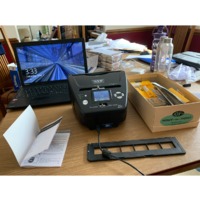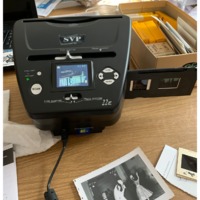Digitization Process
In order to digitize a large number of 35mm slides, and even a few photographs, you must have three items. The first, a computer, the second the slides or photographs, and the third a film and photo scanner. To then put these photos and slides into a database, you need a database software.
Pictured to the right was my set up for digitizing my grandfather's 35mm slides as well as several of his photographs. I used a SVP film and photo scanner, a Toshiba computer, and Omeka S as my software.
To begin, I loaded four slides at once into the positives tray. This is the long rectangle with square holes sticking out of the side of the film machine in the picture to the left. When a photograph is taken on a non-digital camera, it creates a negative image on film. This film can then be developed into positives, or, in this case, a 35mm slide. Since my grandfather had all of his film developed into slides, I will be working with the poitives tray for the film scanner. With the film scanner turned on and changed to the "Film" side, I was able to move the positives tray through its slot to select each slide. The image on each slide appears on the small screen of the scanner where I can change the "EV" of the image resolution, or the exposure value. Once I am happy with its position on the screen and the image's EV I hit the "Scan" button and enter to save it onto an SD card.
Once I have scanned all of my slides I moved on to the photographs. This process was very similar. I slide the photographs into a photograph holder and insert it into a slot on the top of the machine. Once all of the options on the scanner are moved to photograph, I can look at the image on the small screen. From then on, the process is the same as the film scanning process.
Having both the slides and photo scans on the SD card, I can now insert the SD card into my computer and download the images. Using Omeka S, I upload each image into my created item set called "Richard Cronan: Photographs" and create metadata for each image. Since these photographs were taken by my grandfather I decided that the metadata fields should include: Title, Description, Date, Medium, and Creator. This way I could title it myself, describe who was in the photograph and where it was believed to be taken, whether it was a 35mm slide or photograph, and include that my Grandfather took the photo. Once I completed my item set, I created a website so that other family members might see the images. I decided to seperate between decades and include a small biography for classmates.
Using Omeka S ended up being the best case sceniro as I could use a desktop version with the Pratt School of Information Server. This way I was also able to create a front end website for my family to enjoy as well. In the end I wish I could have added more images, but I am happy with the way these turned out under the circumstances.

